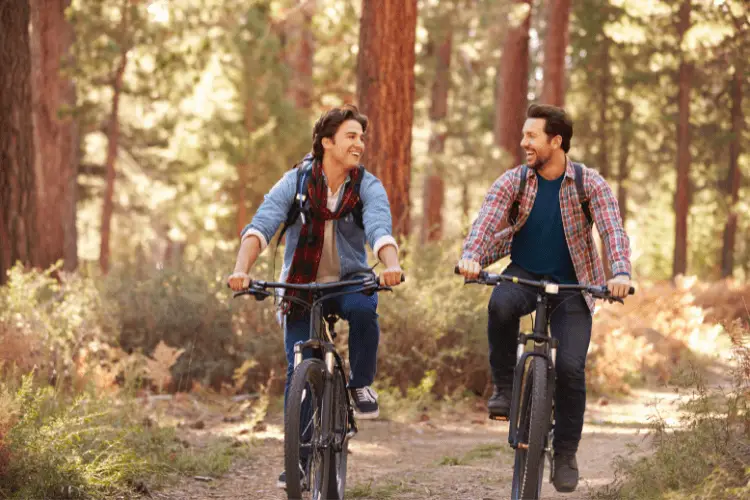Changing weather can be a nuisance if you’re an avid cyclist. You always have to be on your toes and ensure that your apparel is good enough to protect you against extreme temperatures.
At higher temperatures, you can get away with wearing shorts and a t-shirt. However, as the temperature drops, you’ll want to add more layers to stay warm. If it’s really cold, you’ll need to consider wearing specialized equipment and clothing.
In this article, we’ve compiled a list of different gear you can wear in various temperatures to get the most out of your bike ride.
Quick Navigation
What Are Layers, and Why Are They Important?
We’ll be using the word “layer” throughout this article. So, it’s important to discuss what layers are and why they are so vital for cyclists.
There are three layers:
- The base layer is meant to be worn next to your skin and is responsible for absorbing sweat.
- The middle layer is worn on the top and traps air to keep you warm.
- The outer layer helps repel the cold and protects against moisture.
What to Wear at Different Temperatures

70 to 60 Fahrenheit (21.1 to 15.5 Celsius)
At the 70 – 60 degrees temperature range, it’s best to wear the following:
- Light shorts
- Jersey
- Bib cycling shorts
- Cooling base layer (undershirt)
- Fingerless gloves
- Light socks
As the temperature reaches 60 degrees, you’ll notice an increase in the number of bikers wearing long-sleeve shirts and cycling tights.
Of course, some people still wear shorts in the middle of the season, but the majority choose to wear long-riding attire.
Wear a pair of knee warmers at the start of the ride and take them off as the day warms up. In addition to the standard undershirt, wear a jersey and bib shorts.
Also, include a set of arm warmers as a quick extra layer. Arm warmers stop any sweat-induced shivers. You can store them in a jersey pocket.
Additionally, you might need fingerless riding gloves. It’s a crucial piece of apparel that helps avoid excruciating road rash, just like a helmet.
60 to 50 Fahrenheit (15.5 to 10 Celsius)
In this range, it’s best to wear the following:
- Long sleeve jersey
- Cycling shorts
- Knee warmers
- Cap
- Light gloves
- Normal cycling socks
When the temperature is between 50 and 60 degrees, you should consider wearing a long-sleeved jersey and carrying a lightweight jacket.
Additionally, you should ride while wearing arm or leg warmers.
Your body will typically warm up due to the heat your pedaling produces. At the lower end of this range, long-sleeved jerseys are ideal.
In contrast, short-sleeved jerseys and arm warmers are advised when the temperature approaches 60 degrees.
It’s a good idea to start your ride wearing a vest (regardless of the temperature).
If you start to become too warm, you can easily take it off and tuck it into a pocket.
Long-fingered gloves are still necessary, so choose a pair with wind-stopping features. When the temperature approaches 60 degrees, all-fleece gloves are your best friend.
Just make sure the palm has some sort of anti-slip material to prevent your hands from slipping.
50 to 40 Fahrenheit (10 to 4.4 Celsius)
At the 50 to 40 degrees temperature range, it’s best to ride with the following apparel:
- Light base layer
- Insulated jersey
- Full leg warmers
- Insulated riding gloves
- Light cap
- Woolen cycling socks
- Cycling glasses
Near 50 degrees Fahrenheit, you’ll be using a coat and gloves much more frequently.
Winter is here, and the chilly wind makes the below-freezing temperature feel even colder. For this kind of weather, heavier clothing is preferred.
Cycling at temperatures between 40 and 50 degrees requires thicker tights, complete leg warmers, a long sleeve jersey, and maybe a base layer. When it becomes colder, staying dry is even more crucial.
Throughout your bike ride, adjust your moisture management by adding and removing layers or zipping as necessary.
You also need to start considering how to keep your fingers, toes, ears, and head warm.
40 to 30 Fahrenheit (4.4 to -1.1 Celsius)
Now that it’s seriously getting colder.
You need to wear the following to survive:
- Base layer
- Mid layer
- Softshell
- Protective shell
- Thermal tights
- Gloves
- Cap
- Thick socks
- Shoe covers (depending on cold)
When you leave the house, it will be chilly. You will need to begin with a base layer, mid layer, and light outer layer to start your ride.
Your core temperature will definitely drop, so you need to dress appropriately.
A Long sleeve jersey will serve as your first layer, followed by a mid-layer. Next, consider putting an insulating layer over your protective layer or vest.
It takes some preparation to maintain a comfortable body temperature while simultaneously focusing on the track ahead.
Choose a pair of tights or leg warmers to prevent your legs from cramping, and tuck both of them beneath your shorts to protect them from falling off.
Tall wool socks will keep the area between the foot and the ankle warm.
However, avoid the impulse to spend a lot of money on white shoe coverings because they will simply get ruined and torn.
When biking in these chilly conditions, you will still need to put on and take off layers of protection and unzip softshell jackets to let heat out and breathe.
Remember that you can also encounter snow and ice, so be careful.
30 to 20 Fahrenheit (-1.1 to -6.6 Celsius)
While it is recommended that you stay home in these freezing temperatures, many still love a brisk bike ride to get their heart pumping.
If you’re one of these, you need to wear the following apparel:
- Wool base layer
- Mid layer
- Softshell
- Insulated layer
- Protective layer
- Knee warmers with waterproof tights
- Winter gloves
- Skull cap
- Glasses
- Balaclava
- Thick wool socks
Keep your feet dry by starting the journey with dry feet and new socks. Start utilizing disposable toe warmers.
They provide just enough heat so you can ride a little bit longer and take the edge off.
Below 20 Fahrenheit (-6.6 Celsius)
You need to bundle up at this temperature range and not leave anything exposed unless you want to risk getting frostbite.
Experts recommend wearing the following:
- Wool base layer
- Jersey
- Mid layer
- Softshell
- Insulated layer
- Protective layer
- Knee warmers with waterproof tights
- Winter gloves
- Skull cap
- Balaclava
- Face cover
- Glasses
- Thick wool socks
Assuming you want to stay alive and not get frostbite, you’ll need to take some special considerations when cycling below the freezing point.
It’s important to have a layer of insulation against your skin to keep your body heat in.
You can wear a base layer of synthetic material or wool, followed by a middle layer of fleece or insulation, and topped with a waterproof and windproof outer layer.
You’ll also need to pay special attention to your extremities. Make sure to wear gloves and socks that will keep your hands and feet warm.
And if you’re really braving the cold, you should invest in some toe warmers.
Conclusion
In conclusion, we’ve covered what you can wear at different temperatures when cycling.
At cooler temperatures, you’ll want to dress in layers to regulate your body temperature.
When it’s hot out, dress in light-colored, breathable fabrics to help keep you cool.
And always be sure to wear a helmet to protect your head no matter what the weather is like.

1 thought on “What To Wear When Cycling at Different Temperatures?”